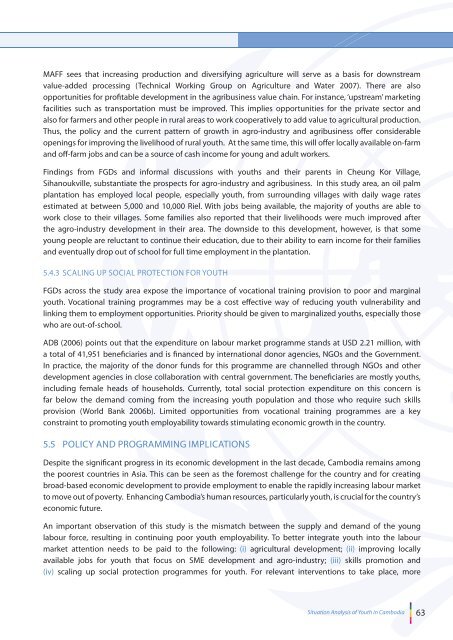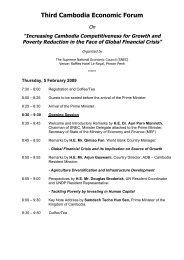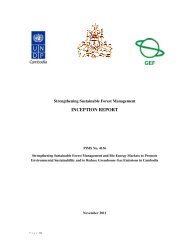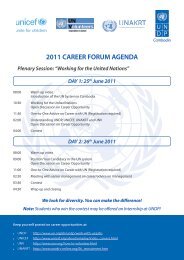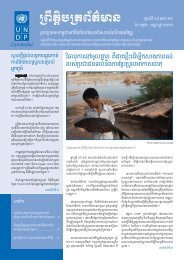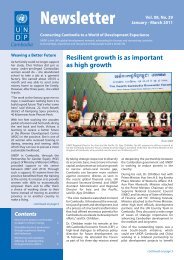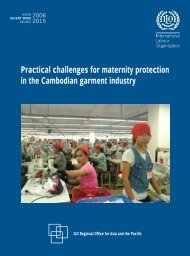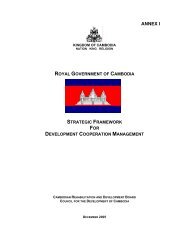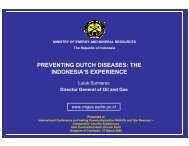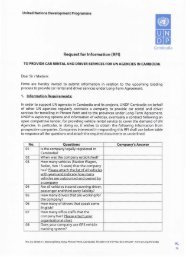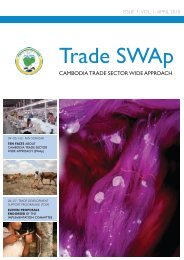UN Analysis Final.pdf - United Nations in Cambodia
UN Analysis Final.pdf - United Nations in Cambodia
UN Analysis Final.pdf - United Nations in Cambodia
You also want an ePaper? Increase the reach of your titles
YUMPU automatically turns print PDFs into web optimized ePapers that Google loves.
MAFF sees that <strong>in</strong>creas<strong>in</strong>g production and diversify<strong>in</strong>g agriculture will serve as a basis for downstream<br />
value-added process<strong>in</strong>g (Technical Work<strong>in</strong>g Group on Agriculture and Water 2007). There are also<br />
opportunities for profitable development <strong>in</strong> the agribus<strong>in</strong>ess value cha<strong>in</strong>. For <strong>in</strong>stance, ‘upstream’ market<strong>in</strong>g<br />
facilities such as transportation must be improved. This implies opportunities for the private sector and<br />
also for farmers and other people <strong>in</strong> rural areas to work cooperatively to add value to agricultural production.<br />
Thus, the policy and the current pattern of growth <strong>in</strong> agro-<strong>in</strong>dustry and agribus<strong>in</strong>ess offer considerable<br />
open<strong>in</strong>gs for improv<strong>in</strong>g the livelihood of rural youth. At the same time, this will offer locally available on-farm<br />
and off-farm jobs and can be a source of cash <strong>in</strong>come for young and adult workers.<br />
F<strong>in</strong>d<strong>in</strong>gs from FGDs and <strong>in</strong>formal discussions with youths and their parents <strong>in</strong> Cheung Kor Village,<br />
Sihanoukville, substantiate the prospects for agro-<strong>in</strong>dustry and agribus<strong>in</strong>ess. In this study area, an oil palm<br />
plantation has employed local people, especially youth, from surround<strong>in</strong>g villages with daily wage rates<br />
estimated at between 5,000 and 10,000 Riel. With jobs be<strong>in</strong>g available, the majority of youths are able to<br />
work close to their villages. Some families also reported that their livelihoods were much improved after<br />
the agro-<strong>in</strong>dustry development <strong>in</strong> their area. The downside to this development, however, is that some<br />
young people are reluctant to cont<strong>in</strong>ue their education, due to their ability to earn <strong>in</strong>come for their families<br />
and eventually drop out of school for full time employment <strong>in</strong> the plantation.<br />
5.4.3 SCALING UP SOCIAL PROTECTION FOR YOUTH<br />
FGDs across the study area expose the importance of vocational tra<strong>in</strong><strong>in</strong>g provision to poor and marg<strong>in</strong>al<br />
youth. Vocational tra<strong>in</strong><strong>in</strong>g programmes may be a cost effective way of reduc<strong>in</strong>g youth vulnerability and<br />
l<strong>in</strong>k<strong>in</strong>g them to employment opportunities. Priority should be given to marg<strong>in</strong>alized youths, especially those<br />
who are out-of-school.<br />
ADB (2006) po<strong>in</strong>ts out that the expenditure on labour market programme stands at USD 2.21 million, with<br />
a total of 41,951 beneficiaries and is f<strong>in</strong>anced by <strong>in</strong>ternational donor agencies, NGOs and the Government.<br />
In practice, the majority of the donor funds for this programme are channelled through NGOs and other<br />
development agencies <strong>in</strong> close collaboration with central government. The beneficiaries are mostly youths,<br />
<strong>in</strong>clud<strong>in</strong>g female heads of households. Currently, total social protection expenditure on this concern is<br />
far below the demand com<strong>in</strong>g from the <strong>in</strong>creas<strong>in</strong>g youth population and those who require such skills<br />
provision (World Bank 2006b). Limited opportunities from vocational tra<strong>in</strong><strong>in</strong>g programmes are a key<br />
constra<strong>in</strong>t to promot<strong>in</strong>g youth employability towards stimulat<strong>in</strong>g economic growth <strong>in</strong> the country.<br />
5.5 POLICY AND PROGRAMMING IMPLICATIONS<br />
Despite the significant progress <strong>in</strong> its economic development <strong>in</strong> the last decade, <strong>Cambodia</strong> rema<strong>in</strong>s among<br />
the poorest countries <strong>in</strong> Asia. This can be seen as the foremost challenge for the country and for creat<strong>in</strong>g<br />
broad-based economic development to provide employment to enable the rapidly <strong>in</strong>creas<strong>in</strong>g labour market<br />
to move out of poverty. Enhanc<strong>in</strong>g <strong>Cambodia</strong>’s human resources, particularly youth, is crucial for the country’s<br />
economic future.<br />
An important observation of this study is the mismatch between the supply and demand of the young<br />
labour force, result<strong>in</strong>g <strong>in</strong> cont<strong>in</strong>u<strong>in</strong>g poor youth employability. To better <strong>in</strong>tegrate youth <strong>in</strong>to the labour<br />
market attention needs to be paid to the follow<strong>in</strong>g: (i) agricultural development; (ii) improv<strong>in</strong>g locally<br />
available jobs for youth that focus on SME development and agro-<strong>in</strong>dustry; (iii) skills promotion and<br />
(iv) scal<strong>in</strong>g up social protection programmes for youth. For relevant <strong>in</strong>terventions to take place, more<br />
Situation <strong>Analysis</strong> of Youth <strong>in</strong> <strong>Cambodia</strong><br />
63


